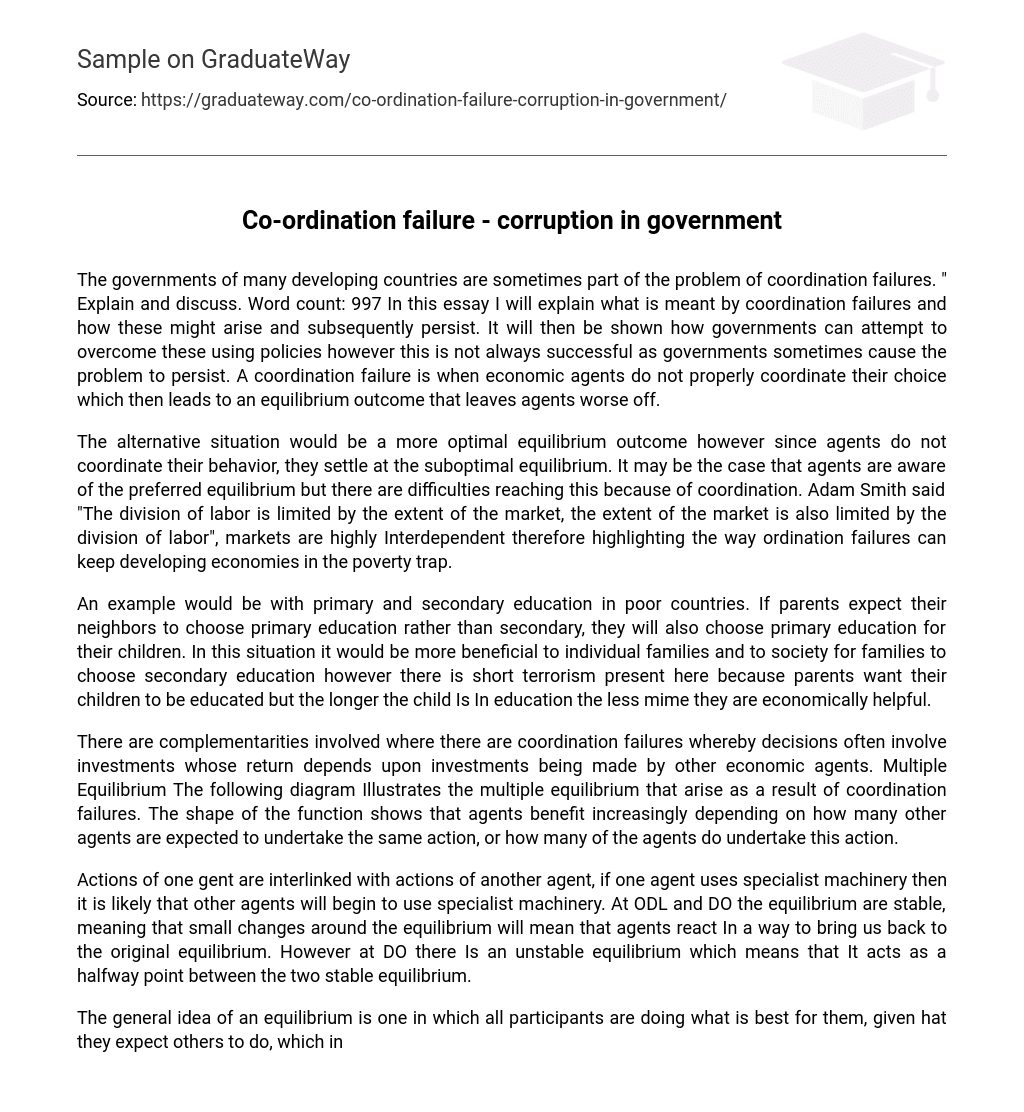The essay discusses how governments in developing countries can contribute to coordination failures. The concept of coordination failures is explained, along with the reasons for their occurrence and persistence. It is also highlighted that governments can implement policies to address these issues, but sometimes they inadvertently exacerbate the problem. A coordination failure happens when economic agents fail to coordinate their choices, resulting in a suboptimal outcome for all involved parties.
The suboptimal equilibrium is reached because agents do not coordinate their behavior. Although agents may be aware of the preferred equilibrium, coordination difficulties prevent them from reaching it. Adam Smith’s statement emphasizes the interdependence of markets and the division of labor. It highlights how coordination failures can perpetuate poverty traps in developing economies.
In poor countries, primary and secondary education choices are influenced by parents’ expectations. If parents expect their neighbors to choose primary education over secondary, they will also opt for primary education for their own children. Although choosing secondary education would be more advantageous for both individual families and society, there is a concern of short-term economic disadvantages as longer duration of education decreases the child’s economic productivity.
In cases of coordination failures, decisions often involve investments that rely on investments made by other economic agents. This creates complementarities. The diagram below illustrates the multiple equilibria that result from coordination failures. The shape of the function indicates that agents benefit more as more agents are expected to undertake the same action or actually undertake it.
Actions of one gent are interlinked with actions of another agent, resulting in the use of specialist machinery by multiple agents. At ODL and DO, the equilibrium is stable, prompting agents to react and restore the original equilibrium in response to small changes. However, DO features an unstable equilibrium that serves as a midway point between the two stable equilibriums.
The concept of equilibrium entails a scenario where all participants act in their best interest, taking into account their expectations of others’ actions, resulting in alignment with the actual behavior of others. This facilitates the achievement of an optimal equilibrium state and efficient resource allocation. These traps generate a harmful cycle of underdevelopment that is difficult to overcome. Therefore, when the market mechanism fails to reach the optimal equilibrium, governments should employ policies to coordinate agents and shift the equilibrium position.
The use of effective government policies is necessary to escape these traps and change expectations. Policy plays a crucial role in coordinating joint investments when there is a time gap between making an initial investment and realizing its return. A possible policy example for correcting coordination failure is to coordinate between workers seeking skills that employers can utilize and the employers desiring specialist equipment accessible in the markets.
Both employees and employers may hesitate to invest in time and money, resulting in a stalemate where neither party takes the first step. This creates a suboptimal equilibrium. In developing countries, governments may exacerbate coordination failures, leading to more failures. According to Joseph Stilling, corrupt government officials should be viewed with suspicion as they profit from funds obtained from public enterprises, thereby perpetuating economies in the suboptimal equilibrium.
Corruption is an unproductive economic activity. Therefore, governments should ensure that public economic agents have the motivation to work productively with those in the private sector. This is crucial for lifting economies out of poverty traps. Furthermore, the presence of corruption leads to a cycle of more corruption, as individuals tend to follow the dishonest actions of others.
Society can either organize itself around corruption or non-corruption. If one person chooses corruption while another doesn’t, the corrupt individual will face penalties. The Nash equilibrium can be either a corrupt; corrupt choice or a non-corrupt; non-corrupt choice. In a corrupt society with high corruption levels, taxation and governments can maintain an inefficient equilibrium. This could happen because government officials and economic agents both benefit personally from engaging in corruption and being dishonest with each other.
According to Hewitt (2001), economic agents’ decisions are influenced by their belief that other agents will make decisions that fully maximize the benefits of trade. However, the issues discussed in this essay contradict this notion as individuals do not always anticipate others to act in this manner. Instead, they anticipate others to be cautious and base their investments on the choices made by others. In reality, it would be more advantageous for them to collaborate and share information.
Government intervention involves the transfer of resources, which can create opportunities for corruption. While many governments try to prevent this, it can be more difficult for developing countries due to limited capacity. As a result, market failures increase and corrupt officials may take advantage if it benefits them.





